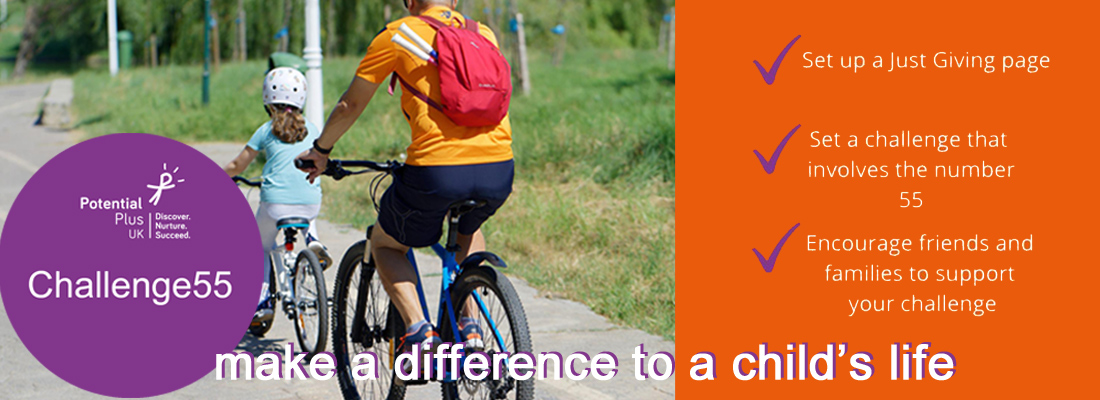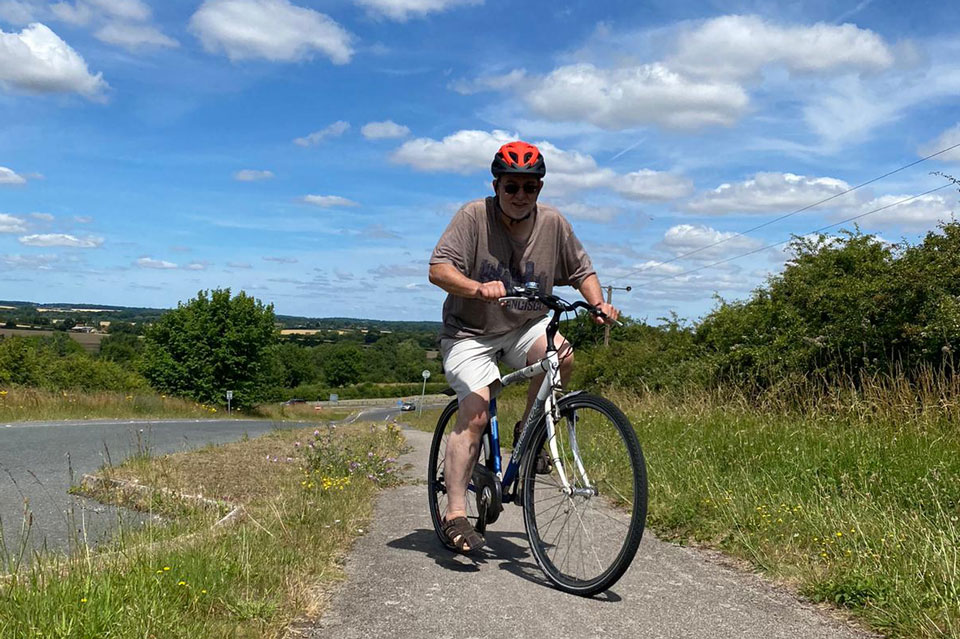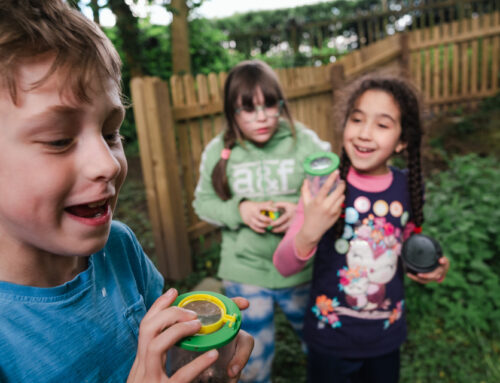Stephen Ramsden is the chair of Potential Plus UK’s Trustees. He rather rashly offered to undertake our first Challenge55 – setting himself the challenge of cycling 55km. Training in the really hot weather in July 2022, he then went on to smash his target of £550 – in the end raising a fantastic £915 for Potential Plus UK. You can read about his challenge in What I Learned By Taking Part In Challenge55. Many thanks to Steve and everyone who will be sponsored to challenge themselves this year to raise funds for Potential Plus UK.
So, a quick recap. My Challenge55 was to cycle 55 kilometres at the end of June. My target was to raise £550, but actually I raised £1,100 when gift aid is included. The two charts below show the distribution of donations in terms of donation size (e.g. 27% of donors donated £10) and proportion of the total each donation size made (e.g. 18% were from people who donated £20). It is interesting to note that although the number of donations of £40 and above were just under 20% they make up about 50% of the total value.
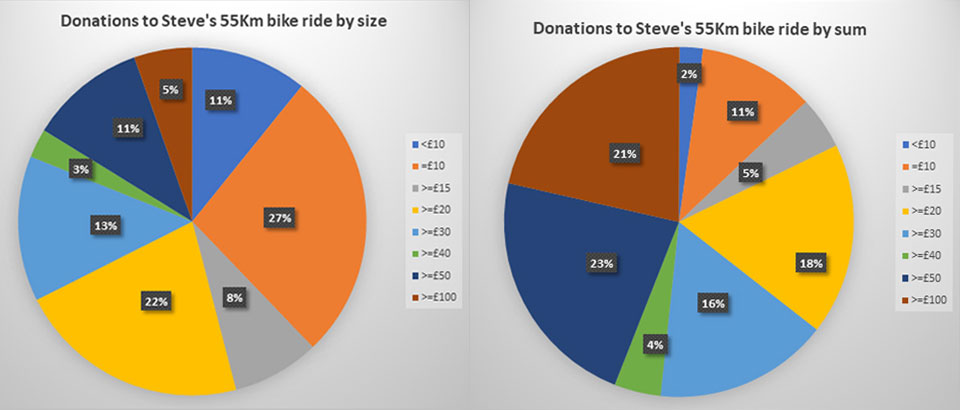
Here are 10 practical tips which I used to achieve this stonking result:
- Set stretching targets (both in event and money raised)
- Plan effectively (allow enough time to gain awareness/response, allow time to practise)
- Use multiple channels
- Don’t assume once is enough
- Master how the technology works
- Design your wording (e.g. adapt your pitch to your audience, thank your donors, etc.)
- Use updates to keep people engaged
- Encourage involvement in the charity
- Use effective graphics/images
- Follow up after you complete your event.
1) Set stretching targets (both in event and money raised)
Set yourself a stretch target i.e. something a bit beyond what you’ve done before and that you can be genuinely proud of achieving. If your challenge is not a foregone conclusion, it will come across in your communications to your supporters and will make them more willing to support you. Also having something you aren’t sure you can actually do will make you draw deep on your resources and will build your confidence for future challenges in your life.
Setting a stretch target for the money you want to raise is also a good idea. Firstly it has a chance of raising more money for the charity (the reason you are doing this in the first place), but also you want to set a target which will take some time to reach, as this gives you the opportunity to use the other stuff I talk about later. If your target is too low it will be achieved quickly and later supporters may feel they don’t need to contribute (or contribute as much as they might have). If you don’t reach your target – so what ? you’ve still raised some money.
I set myself a target of £550 which I thought would be possible but difficult to achieve. I thought that even if I only raised half of this (my first thought was £250) I would have been quite happy. I calculated that I knew about 55 people who could be persuaded to donate £10 to my challenge (with a bit of arm twisting!), if I could contact them all in time for them to get involved. In fact I raised £1,100 achieving double my target – so 4 times my original idea! I feel quite proud of that.
A friend of mine completed the Chiltern 50km ‘Ultra walk’ last weekend. She set herself a target to raise £250 for a charity and raised £825 from 30 supporters. I don’t know for sure whether I raised more because I reached more people or because I set a higher target, but I will give the benefit of doubt to the target whilst also trying to reach as many people as possible!
2) Plan effectively
Spend time producing a good plan. Time is never wasted spending time thinking through your challenge and that starts with asking lots of questions and trying to answer them. Don’t forget to think about what could go wrong and what you can do if it does.
- What are you going to do? How long will it take?
- What preparation do you need and how long will you need for it and fundraising?
- Do you have the expertise to pull it off? If not, how can you get the expertise you need?
- If it is too difficult, can you cut it down to something achievable but still challenging?
- What is the average amount you think donors will give you?
- How many people will donate? Will multiplying these figures achieve your target?
- If not, can you reach more donors or should you reduce your target?
- Or should you stretch your target a little?
- How are you going to contact your donors? and when?
- How can you get them / keep them involved?
Working through all your questions will suggest things you can do or which are necessary to achieve your goal. When I began planning, I quickly realised a few things I needed to factor in. I needed to:
- train to get used to the 4 hours I needed to cycle to complete my challenge
- get fitter
- allow sufficient time for the above (at least a month)
- service my bike (at one point the seat fell off and I didn’t have a pump)
- allow time to contact my potential donors several times
- understand how the Just Giving website worked
- start my challenge at least a month before I actually did it!
A few things went ‘wrong’ on my challenge which my plan addressed, and one thing went wrong which my plan didn’t cover. Here are the things which my plan accommodated:
- I needed to communicate with 55 people (my assumption being that 55 people would be prepared to donate £10). To allow myself time to communicate and for them to respond I planned to start my campaign over a month before the date of my challenge. See the tip below under Don’t assume once is enough how this worked out. By the end of my campaign 37 people had donated or just under 70% of my target. Although about a quarter donated £10 the average donation was £25.
- My ride was to be 55km and I had worked out a route which on paper was 55km. A planned rehearsal ride of the complete route showed that it was only 53km. So I extended it by a diversion around our park which took it to 56km.
- It was the hottest summer on record – I planned a very early start at 6.30am to keep cool and took plenty of water. This worked and I finished at 10.30am before it started to get really hot. I also drank all my water.
- The seat fell off my bike. However I had planned a number of training rides and this happened on one of these, so I got my bike fixed in good time for the actual challenge.
- I thought I might get a puncture, so I bought a puncture kit, a pump and practised pumping up my wheels (I didn’t get a puncture).
And then something happened which my plan didn’t cover. I had planned for my son to accompany me on the 4 hour ride in case of accident/etc. Unfortunately he caught Covid the week before my ride, so in the end I took a small risk riding alone, but adapted my plan by texting my wife when I reached pre-identified route markers.
Recognising the value of good planning will pay you back many times in your life!
3) Use multiple channels
By channel I mean a communication medium such as email, Facebook or WhatsApp. Use multiple channels and don’t just rely on one channel for contacting your donors. This is worthwhile because:
- Not everyone can be reached with one channel, so using one channel will automatically limit the number of potential donors you can reach, and
- Reaching the same people through different channels can reinforce your message and remind people about your challenge.
The pie chart below shows which channels my donations came from. It’s true that email accounted for about 75% of my donations but actually I approached the three groups (family/friends/work colleagues) in very different ways with different email wording and that still left £275, a quarter of donations, coming from the other channels.
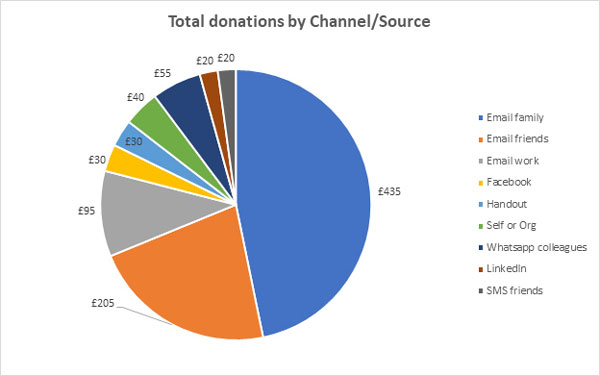
4) Don’t assume once is enough
If you email someone (or post you are doing your challenge on Facebook) very few people will immediately click on the link to your Just Giving page and donate to your challenge. Most people will read it and say “Oh that’s interesting I must donate…”, but then won’t immediately do anything about it and will forget it. So communicating on a channel once is not enough. You need to remind them! You will find that most people will actually donate on the second or third reminder. I had four people donate after I had completed my challenge, one saying “… it’s not too late to donate is it?” (it wasn’t).
This means two things. Firstly, you have to allow enough time to send out several messages about your challenge to your target audience, and secondly, you need to think about how to change the wording of your reminders to keep it interesting and to keep your audience engaged (except for family of course – they have to donate don’t they, otherwise you will make their lives a misery!).
I chose to keep up a running commentary on how my training was going, how much of my circuit I had completed, the fact that we had all those fires in the summer but it wasn’t going to stop me (I must admit that wasn’t planned for!), etc.
The figure below is interesting. It shows when donations came in. All my initial communications were completed at the end of June. I then sent out another communication on my channels on 13th July and then again on 16th July (I completed my 55km bike ride challenge on the 29th July). So you can see that each round of communications triggered a set of donations with lulls between, and out of the 37 donations only 4 came in after my first communication about my challenge. So once is definitely not enough. The highest wave of donations (16) came in the week after my 3rd communication, with the second highest wave (9) coming in the two days after my second communication.
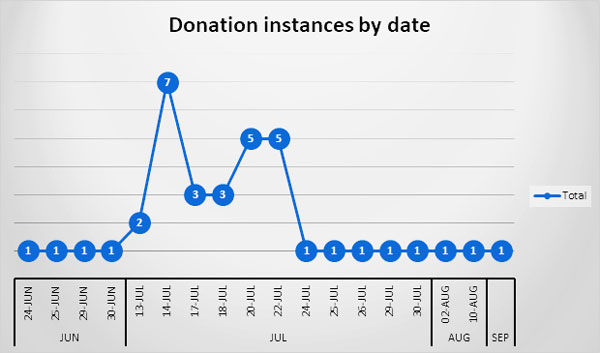
5) Master how the technology works
Make sure you understand how the technology you are going to use works and use its features.
For example:
BikeMap is an app I found to monitor how far I cycled, to plot my journey and upload the route and stats when I finished – see here. However in learning to use it I found that it had a high use of my battery and I needed to be careful to avoid my mobile phone running out of power and losing the information about my ride.
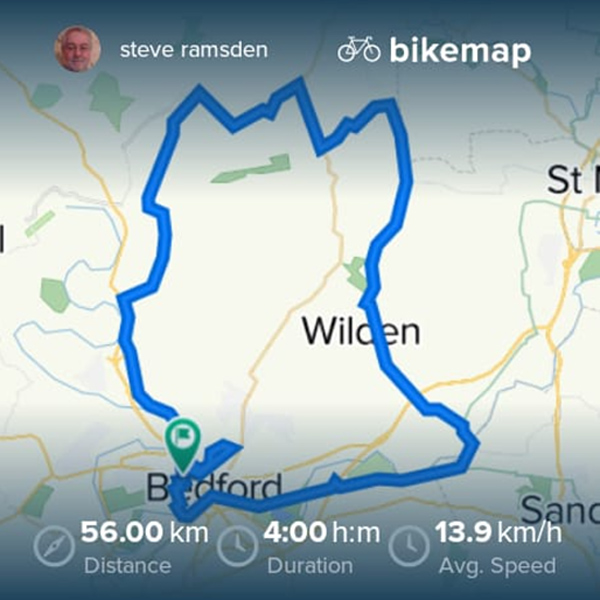
JustGiving enables you to:
- Create a page for your challenge, but within constraints for the number of words you use to describe it. Understand the limits and work within them.
- Link to the charity’s Just Giving page automatically. This will allow people visiting your page to explore the charity.
- Set up an automatic thank you for anyone who donates. This saves you time!
- Post updates about how your challenge is going. I used this every few days.
- Monitor who has donated to your Challenge. Use it to keep tabs on donors and follow up targeting people you know have not donated yet.
- Produce a QR code which enables anyone with a QR code reader to link directly to your Just Giving page. I used this to print some paper copies for a few people I didn’t have contact details for (see image).
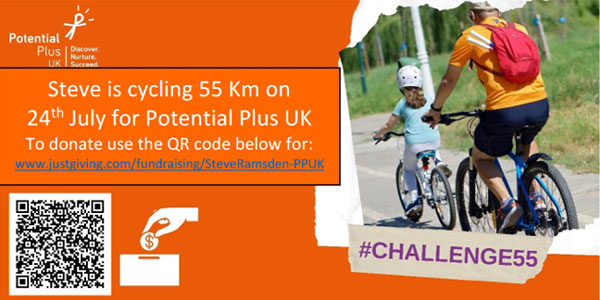
6) Design your wording
Spend some time thinking about what is likely to influence your audience to donate. Keep it short but long enough to explain what you are doing. Perhaps stress how grateful you are if people feel able to donate – people always like to feel appreciated. Perhaps stress how much good the charity does – linking to the case study/stories. Perhaps show some vulnerability by saying you’ve never done this before and you hope you will be able to complete it, to engage their empathy. Perhaps use some of the wording provided in the fundraising pack or on the website.
It is a fact that good wording gets better results, which is why there is an advertising industry! It is always a good idea to:
- adapt your wording to your audience to make it appeal
- explain what you are doing (and why it is a challenge for you)
- tell them a little about the charity and why it is worthwhile (particularly if you have some personal experience)
- emphasize your gratitude for anyone willing to support your challenge.
7) Use updates to keep people engaged
Because you need to communicate with people a number of times before they will be motivated to respond, you need to plan how to do this. It’s probably not a good idea just to send the same message because people may find that irritating and it may put them off.
Using updates on your Challenge can be a good way to circumvent this issue. Essentially you are making the – not-unreasonable – assumption that they are going to be interested in how you are getting on with your challenge. By telling them about your progress you are subtly reminding them that you are looking for them to sponsor you without the need to actually ask them again. However, always remember to include a link to your Just Giving page at the bottom of your update!
It you use the option on Just Giving to post updates you can take selected updates from there to include in follow up communications on your various channels (e.g. email/Facebook/Instagram/etc.). It also means that when one of your potential donors is moved to click to your Just Giving page they have the opportunity to read about your progress, building empathy and making them more likely to support you.
8) Encourage involvement in the charity
Remember that although the main aim is to raise money for the charity, we also want to raise awareness about the charity itself. Every time someone reads something about Potential Plus UK is an opportunity to make a connection with someone who could benefit from the services we offer. Most families with children with high learning potential in the UK either don’t know they have children with high learning potential or if they don’t know how best to support them. Potential Plus UK can offer a lifeline to them and potentially improve the life chances for their children. You may have some direct proof of this. If so, tell people about it.
9) Use effective graphics/images
A picture says a thousand words and this is even more true today with so much communication happening on social media. People are much more likely to stop to read an item with an engaging picture than just plain text.
Even in this blog the images probably engage you more than all the words I’ve written. So, if for your challenge, and for your progress in preparing for it, you can find relevant images to support what you are doing, use them to the full.
Probably the best combination is:
- A relevant or engaging image
- A short covering note of one or two paragraphs
- A link to your Just Giving page.
10) Follow up after you complete your event
Finally make sure you follow up after your event. You have engaged their interest enough to get them to contribute to your challenge and they will be interested to know how you did. Tell them. You never know you may want to do another challenge in the future and need their support.
Best of luck with your challenge and let us know how you get on too!
If you have been inspired by Steve’s efforts to undertake your own Challenge55. See our website page Challenge55 for more information about how to join in. Please let us know what you are doing so that we can share your effort and achievement widely.
